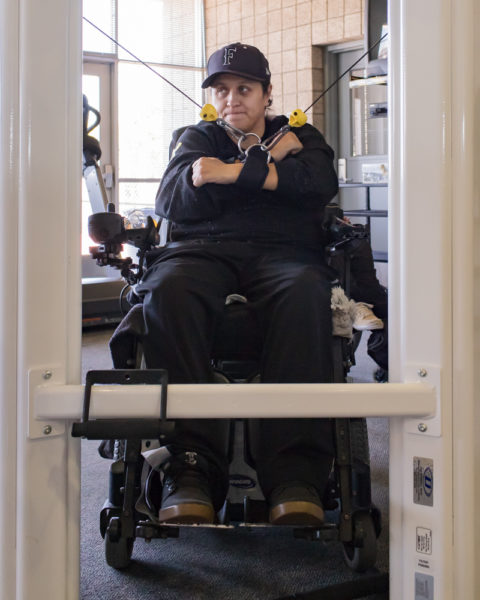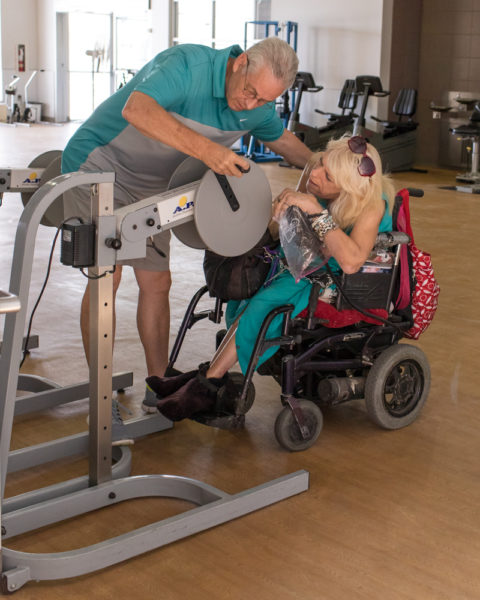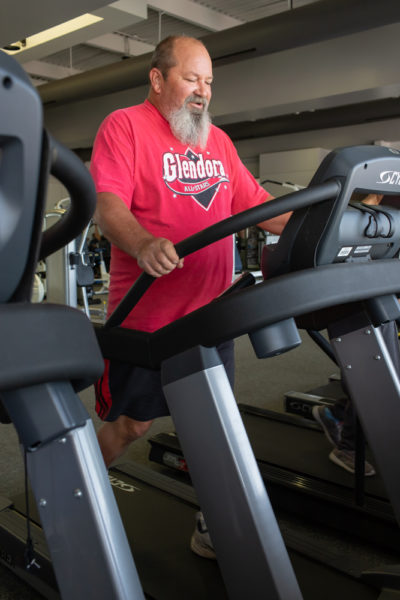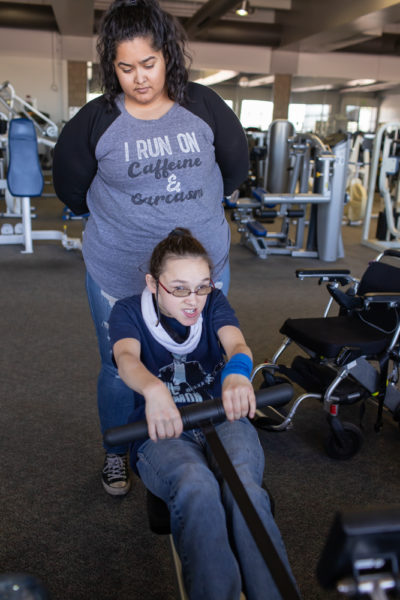Despite the numerous gyms and fitness centers in Glendora, only one offers a place to work out for the disabled community. That place is the Regional Adaptive Physical Education Center at Citrus College.
Disabled students and members of the community who need special equipment can come to the center to work out. Instructors work with them to adapt exercises to their specific needs.
Dalia Davila, 25-year-old photography major, has autism and an ankle injury. After taking the adaptive aquatics class, she is now taking the adaptive P.E. class.

“It reduces stress… I love to work out,” Davila said. “…(Students can) work at your own pace. …People with disabilities can do their own workout.”
Laura Chavez, 49-year-old academic counseling major, is another Citrus student who attends the adaptive P.E. class. She has cerebral palsy which makes movement difficult, particularly in her right hand and her legs.
“(Working out) doesn’t tire me,” Chavez said. “…It’s relaxing… and improves my health, my blood pressure and keeps my muscles active.”
Aides and instructors help strap Chavez to the standing machine which allows her to stand with support and to be out of her wheelchair. Her favorite machine is the NuStep, a recumbent cross-trainer that simulates walking, because it “builds strength in my legs,” Chavez said.
Kathleen Hernandez, 36-year-old business major, played competitively in high school on softball, basketball and roller hockey teams. She played other sports as well.
In September 1999 after starting her junior year in high school, a car accident changed Hernandez’s life. She could no longer walk.
Hernandez uses a wheelchair. She has movement in her arms but has no grip strength. However, exercising continues to be a part of her routine. She works out in the adaptive P.E. center four times a week.
“(I come) to stay active, flexible and to keep my strength up,” Hernandez said.
Besides working out, the adaptive P.E. students rave about their instructors as being wonderful, supportive and motivating. Steve Hartman, fitness center coordinator and instructor, works closely with each student, instructing on technique and explaining exercises to them.

“Mr. Hartman is very encouraging,” Chavez said.
“(The instructors) are amazing, incredible and keep me motivated,” Davila said.
Hartman started the adaptive P.E. program in 1987. A single class of 15 students meeting in the old west gym grew to three adaptive P.E. classes and one adaptive aquatics class.
Hartman also feels positive about the students and the program.
“I love the students, the administration has been very supportive of the program and we’ve been able to grow,” Hartman said. “…They’re (the students) wonderful to work with… and they work hard to overcome their disability.”
Helen Jeng, program coordinator, has also worked with adaptive P.E. for 30 years. She said she finds that the positive energy from the students rubs off on her.
“It’s a wonderful job…the students are so much fun to be with and you never hear complaints from them,” Jeng said. “…They just love being here. …We also enjoy the interaction with each student as they bring such positive energy to class.”
Besides working behind the scenes so the programs run smoothly, Jeng said she helps students with the equipment and assesses their progress from the beginning to the end of the semester. She also focuses on the “emotion well being of the students, along with the incorporation, transition and the retention of the student with a disability into the college environment.”
Instructors assess students’ progress each semester so that they and the students can see the progress they are making. Whether it’s lowering blood pressure, increasing grip strength or increasing bicep strength, everyone strives to improve their health, strength and mobility.

Stephen Crall, 63-year-old resident of Glendora and former heavy equipment operator, said he has seen a great improvement in strength and mobility in his two years of working out at the adaptive P.E. class.
On Aug. 8, 2015, Crall fell in the basement of his home, hitting his head and damaging his C3 to C6 vertebrae located at the middle of the neck. He was in the hospital for two months and spent a year in out-patient therapy.
“After that, I had nowhere to turn,” Crall said.
Crall heard about the adaptive P.E. center from his daughter and has been coming ever since.
“I have been coming for two years,” Crall said. “…My left side still has serious damage. …I don’t look at it as school or class. It’s my therapy, what keeps me going.”
Crall said he is determined to get stronger and work harder. In September, he climbed a 20 foot tall rock wall and reflected that he was “faster this year.”
After class on Oct. 16, he said he set a new record for himself by walking for two miles at 2.9 mph in 41 minutes, doubling the distance and time of when he first joined the class.
Family members of the students like to see the progress they are making. Larry Hughes brings his daughter Elina Hughes, 23, to the center. Since she first started coming four years ago, he said he has seen her grow stronger.

“[I] like all the machines,” E. Hughes said.
Athetoid cerebral palsy does not stop E. Hughes from lifting weights and rowing hard on the rowing machine. L. Hughes said he takes her on bike rides regularly where she rides and steers her own bike.
The students, aides and teachers have developed friendships and camaraderie among each other. They challenge each other. They work hard. They also argue about their favorite college teams. An ongoing battle exists between some students, USC fans, and Hartman, a UCLA fan.
Hartman said he hopes the program will continue to grow. He has a vision for wheelchair activity classes, such as wheelchair tennis or basketball.
He also encourages others to, “feel free to come by and visit and see it any time because they might have a family member, a neighbor, a friend who might benefit from this program and they just don’t know about it. …People just don’t know and they could be benefitting from the program.”
Adaptive P.E. classes meet Mondays and Wednesdays from 10:15 a.m. to 11:50 a.m. and 12:05 p.m. to 1:40 p.m. and Tuesdays and Thursdays from 10:15 a.m. to 11:45 a.m. Adaptive aquatics meets Tuesdays and Thursdays from noon to 1:10pm.


